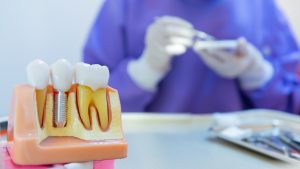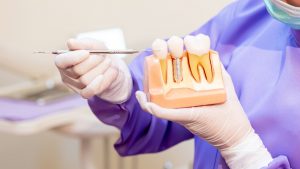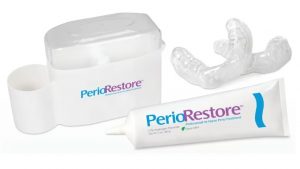Deep cleaning is a dental procedure aimed at treating gum disease by removing plaque and tartar from below the gumline. It’s an important step in improving gum health and preventing future dental problems. However, one of the most common concerns people have about this procedure is whether it is painful.
In this article, we will explore the question: “Is deep cleaning painful?”. We’ll address common misconceptions, explain the factors that influence discomfort, and provide insights based on research and expert advice. Our goal is to help you understand what to expect during the procedure and why pain might not be as much of an issue as you might think.
Pain: Fact vs. Fiction
A common misconception about deep cleaning is that it’s always a painful procedure. This myth likely comes from the idea that cleaning below the gumline would naturally cause significant discomfort. However, deep cleaning is not as painful as some may think. In reality, most patients experience only mild discomfort during the deep cleaning procedure.
The level of pain, or discomfort, can vary based on several factors. These include the health of your gums, the amount of plaque and tartar buildup, and your personal sensitivity. For some, it may feel similar to a regular cleaning, while others may experience a bit more sensitivity, especially if their gums are inflamed or if the cleaning is more intensive.
It’s important to note the difference between discomfort and pain. Discomfort usually refers to mild sensations like pressure or tenderness, while pain is more intense and sharp. During deep cleaning, most people will experience some discomfort, but this is typically temporary and can be managed with anesthesia or numbing agents.
Factors That Influence Pain During Deep Cleaning
The level of discomfort experienced during a deep cleaning procedure can vary depending on several factors. While many people tolerate the procedure well, understanding the factors that influence pain can help set more realistic expectations.
Gum Health
One of the most significant factors that can affect discomfort during deep cleaning is the health of your gums. If your gums are inflamed or infected due to periodontal disease, the procedure may cause more sensitivity or discomfort.
Inflamed gums are often tender, and cleaning beneath the gumline can make this sensitivity worse. However, deep cleaning is a crucial step in treating gum disease, and while it may feel a bit uncomfortable, it ultimately helps to improve gum health and reduce inflammation over time.
Procedure Depth
The extent of the cleaning also plays a role in the level of discomfort. In cases of severe plaque and tartar buildup, your dentist may need to perform a more thorough cleaning, which could involve working deeper beneath the gumline.
Deeper cleanings tend to be more invasive and might cause a higher level of sensitivity during and after the procedure. On the other hand, if you only require a light cleaning, discomfort may be minimal.
Patient Sensitivity
Each patient’s sensitivity to pain is different. Some people have a higher pain threshold, while others are more sensitive. Additionally, factors like age and medical conditions can influence how a person experiences pain.
For instance, older adults may experience more gum tenderness, while certain conditions like diabetes or dry mouth may make gums more sensitive. Patients with dental anxiety might also perceive the procedure as more painful due to heightened stress or fear, even if the physical discomfort is minimal.
Skill of the Dentist
The experience and skill of your dentist can significantly influence how comfortable you feel during the procedure. A skilled dentist can perform the cleaning efficiently and gently, reducing pressure on sensitive areas. They can also use modern tools, like ultrasonic scalers, which minimize discomfort by removing plaque more effectively with less physical pressure.
Communicating openly with your dentist about your concerns can help make the process more comfortable. If you’re considering deep cleaning, Deep Cleaning Services at My Smile Dental Care are designed to ensure you experience minimal discomfort while improving your oral health.
Pain Management During Deep Cleaning
While deep cleaning is generally well-tolerated, managing discomfort is an essential part of the procedure. Fortunately, there are several pain management options available to ensure the experience is as comfortable as possible.
Anesthesia Options
One of the most effective ways to manage discomfort during deep cleaning is through the use of anesthesia. Dentists typically use local anesthesia, which numbs the area being treated. This prevents any sensation in the gums and teeth, making the procedure virtually painless for most people.
There are a few different numbing agents that can be used, such as lidocaine, which is commonly applied via injection or topical gel. The local anesthesia takes effect quickly, numbing the targeted area so that you can undergo the procedure without feeling discomfort. The numbing effect lasts for a few hours after the procedure, which helps manage any temporary soreness.
Sedation Options
For patients who experience high levels of anxiety or fear about dental procedures, sedation options are available to make the process more comfortable.
Oral Sedatives:
These are medications taken by mouth before the procedure to help relax you. While they don’t numb the area, they can help reduce anxiety and make the experience more tolerable.
Nitrous Oxide (Laughing Gas):
Nitrous oxide, commonly known as laughing gas, is a mild sedative inhaled through a mask. It helps you relax during the procedure without making you fall asleep. It’s effective for reducing anxiety and pain perception, and the effects wear off quickly once the mask is removed.
IV Sedation:
For those with severe anxiety or fear, intravenous (IV) sedation can be an option. This form of sedation is administered through a needle in your arm, making you feel deeply relaxed or even drowsy. You’ll remain conscious but may not remember much of the procedure afterward. IV sedation is typically used for longer or more invasive procedures.
Managing Sensitivity in Sensitive Areas
If you have areas of your mouth that are particularly sensitive, your dentist may take extra care to target those areas with minimal discomfort. By focusing on one section of your mouth at a time and using local anesthesia strategically, the dentist can ensure that you’re not experiencing pain in multiple areas at once.
In some cases, the dentist may also use specialized tools, such as ultrasonic scalers, that are gentler on sensitive tissues while still effectively removing plaque and tartar. You can also help minimize discomfort by following a few simple tips:
- Pre-Procedure Care: Let your dentist know if you have any particularly sensitive areas or if you’ve experienced discomfort during past dental visits.
- Post-Procedure Care: After the procedure, gently brush and rinse with warm salt water to promote healing and reduce sensitivity.
For additional oral care, you might be interested in learning how to clean your teeth with hydrogen peroxide. This method can help maintain oral hygiene in between dental visits.
Pain management during deep cleaning is about ensuring that you feel as comfortable as possible. By discussing your concerns with your dentist, you can explore the best pain management options for your needs and have a smoother experience overall.
How Painful is Deep Cleaning on a Scale?
Understanding the level of discomfort associated with deep cleaning, or scaling and root planing (SRP), can help alleviate concerns and set realistic expectations. Here’s what you might experience based on clinical studies, patient testimonials, and dentist feedback,:
Patient Experiences: Mild to Moderate Discomfort
A study published in PubMed found that after SRP, 28% of patients reported faint-to-weak pain, 18% experienced weak-to-mild pain, and 28% had mild-to-moderate pain. Only 8% reported moderate-to-strong pain, and another 8% experienced strong-to-intense pain.
The average duration of mild or greater pain was about six hours, with pain levels returning to pre-SRP levels by the morning after the procedure. These statistics suggest that while some discomfort is common, significant pain is relatively rare.
Dentists emphasize that advancements in techniques and anesthesia have made SRP procedures more comfortable. We at MySmile Dental Care note that while some patients may experience mild discomfort, most find the procedure tolerable and manageable with appropriate pain management strategies.
Post-Procedure Sensitivity: What to Expect

After a deep cleaning procedure, it’s normal to experience some sensitivity as your gums begin to heal. Understanding what to expect can help you differentiate between typical recovery symptoms and signs that may require further attention.
Immediate Effects
Immediately after your deep cleaning procedure, you may experience minor discomfort in your gums. This is particularly common if your gums were inflamed or infected before the cleaning. The discomfort often feels like a mild soreness or tenderness and typically lasts for a few hours or up to a day after the procedure. You may also notice some swelling around the gumline, especially in areas where plaque and tartar buildup was more extensive. This swelling is generally temporary and should subside as your gums heal.
In some cases, your dentist may recommend over-the-counter pain relievers, such as ibuprofen, to help reduce discomfort and swelling in the first 24 hours after the procedure. Applying a cold compress to the outside of your mouth may also help alleviate any swelling or soreness.
Long-Term Sensitivity
While immediate discomfort usually fades within a few hours to a day, some patients experience longer-lasting sensitivity, particularly in areas with deeper cleaning. This sensitivity can last anywhere from a few days to up to two weeks. You may notice heightened sensitivity to hot and cold foods and drinks, especially in the days following your cleaning.
However, this type of sensitivity should gradually improve as your gums heal. Most people find that after a few days, the discomfort becomes much less noticeable, and by the end of two weeks, it’s typically gone. If the sensitivity persists for longer than expected or becomes more intense, it may indicate that something else is going on and should be addressed with your dentist.
Normal vs. Abnormal Symptoms
It’s important to distinguish between typical post-cleaning sensitivity and potential complications:
- Normal Symptoms: Mild soreness, tenderness, and swelling in the gums are completely normal after deep cleaning. Sensitivity to temperature may also be expected but should diminish within a few days to a couple of weeks.
- Abnormal Symptoms: If you experience severe pain, persistent bleeding, or if the swelling does not subside after several days, it could indicate an issue like infection or an allergic reaction to the anesthesia or cleaning materials. In such cases, it’s important to contact your dentist for further evaluation.
By keeping an eye on your recovery and following your dentist’s post-care instructions, you can ensure that your gums heal properly and that any discomfort you experience is part of the normal recovery process. If anything feels unusual, don’t hesitate to reach out to your dentist to ensure everything is progressing as it should.
Conclusion
In conclusion, most people find deep cleaning to be a manageable procedure with only minimal discomfort. While some temporary sensitivity or mild soreness is common, particularly in areas with significant plaque or tartar buildup, the discomfort usually fades within a few hours to a couple of days. For the vast majority of patients, deep cleaning does not result in significant pain, and pain management options such as local anesthesia and sedation help to make the process as comfortable as possible.
The key to a smooth and successful deep cleaning experience lies in receiving care from a skilled and experienced dentist. Professional care ensures that the procedure is performed efficiently and with minimal discomfort. By openly communicating with your dentist about any concerns and following their post-care instructions, you can help promote faster healing and a more comfortable recovery.








